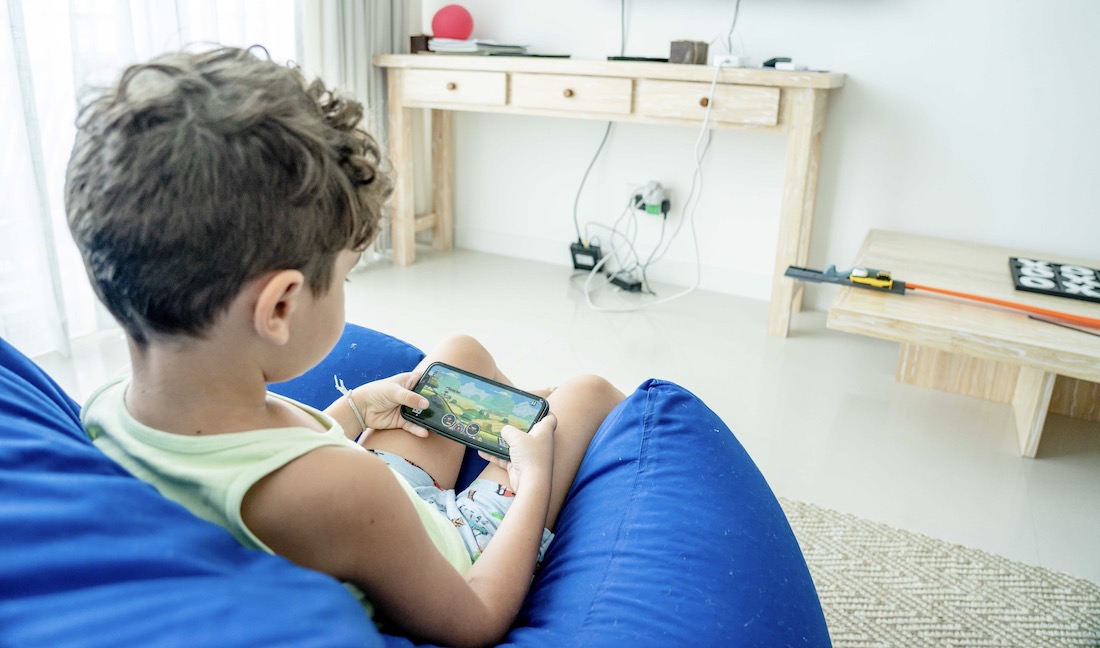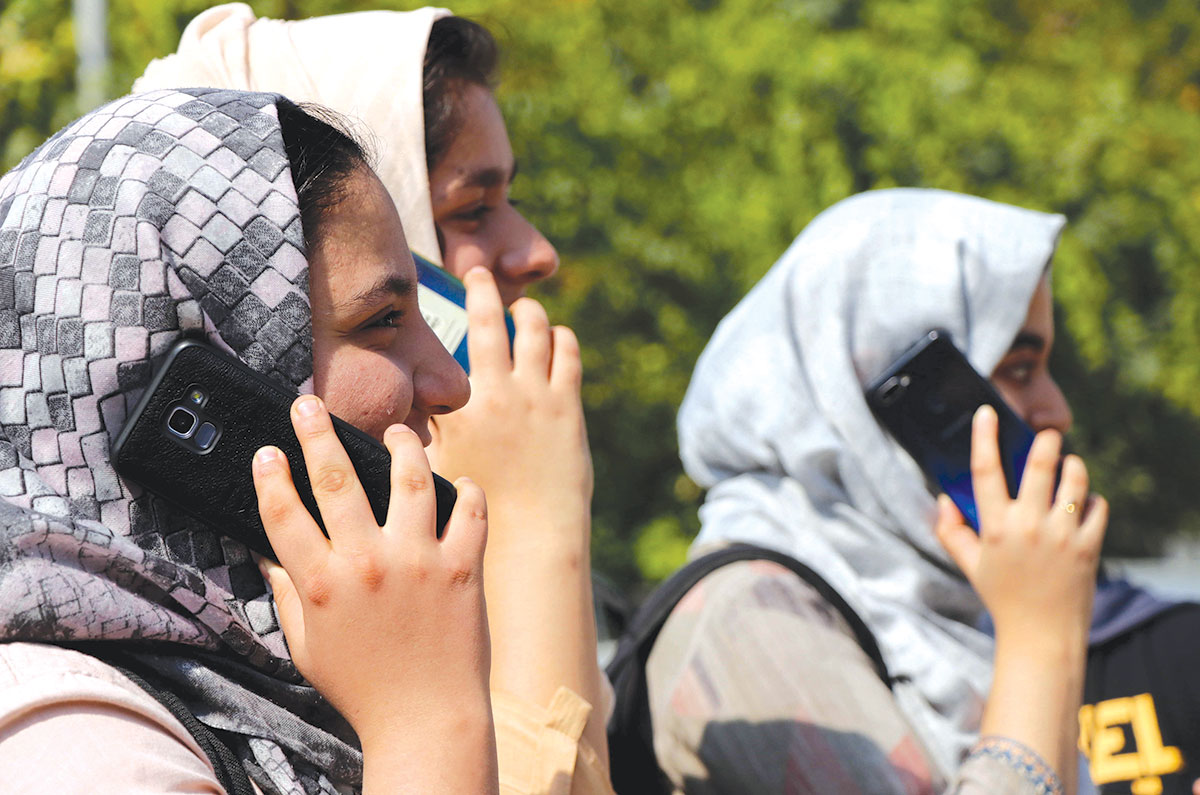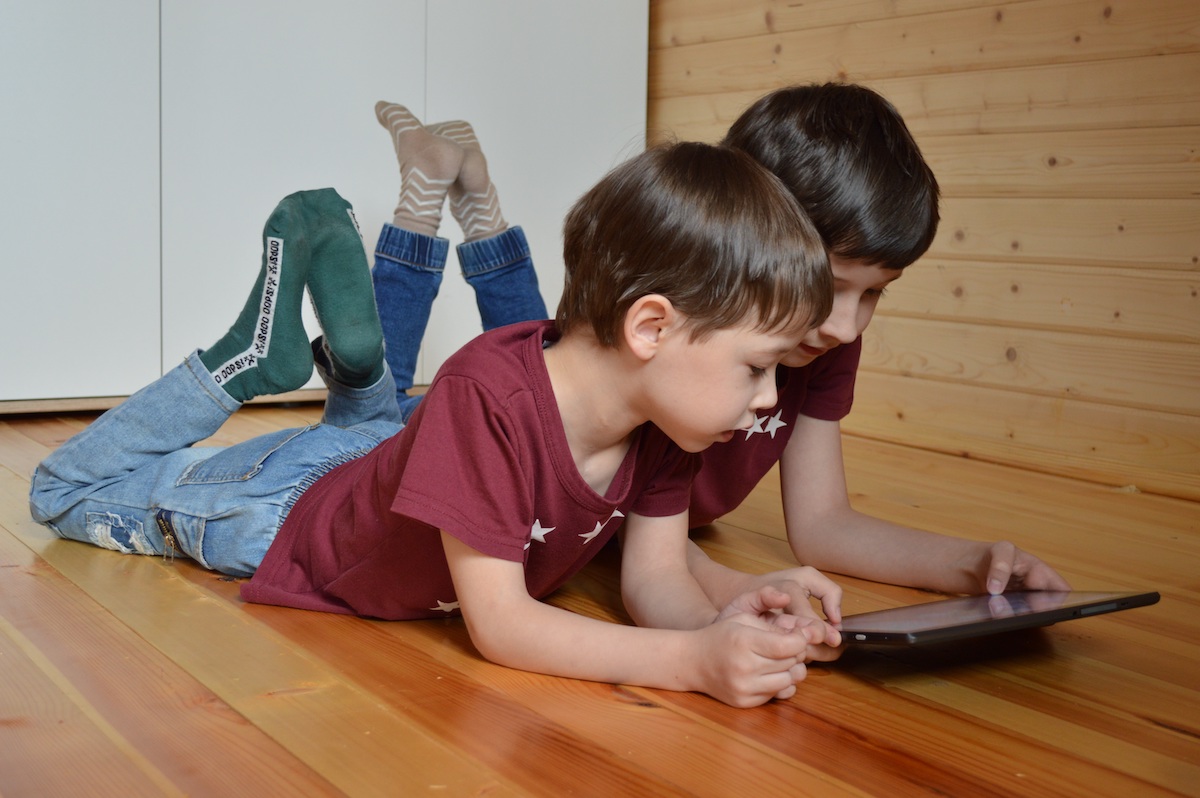In Kashmir’s digital divide, childhood is emerging most vulnerable life space. The potential detachment from traditional enriching elements, the rise of sedentary lifestyles among children, are widening generation gaps, and the prevalence of academic stress leading to psychiatric disorders in adolescents. Syed Shadab Ali Gillani explores three generations and the impact of technology on modern-day childhood.
While sorting through her cluttered closet, 31-year-old Samma stumbled upon a weathered box brimming with remnants from her vibrant childhood. As she delicately lifted the lid, a flood of nostalgic memories unfolded, transporting her back to an era of innocence that seemed worlds away from the experiences of contemporary children.
Samma carefully extracted the treasures within – remnants of the makeshift playhouse crafted from garden mud, flowing lengths of her mother’s discarded dupatta used as a regal robe while teaching imaginary lessons to students disguised amidst backyard greenery, small pebbles forming her rock garden, and sticks artfully transformed into a stethoscope by her father – a prop that fuelled her daily adventures in make-believe.
“It was the golden phase of my life,”, Dr Samma Bashir said reflecting on those bygone days of imaginative play now encapsulated within the confines of the tattered box hared. “Little did I realise then, but those seemingly trivial games and imaginative plays paved the way for who I am today. It took time for me to acknowledge that there was more than just hard work behind my journey to becoming a doctor. The foundation was laid during the enchanting moments of my childhood – moments that seem almost alien when trying to explain them to my daughter in this vastly different era.”
“Imaginative play” involves a child pretending to experience various scenarios, such as engaging in a ‘school’ game with their toys. Children may participate in creative play either independently or with companions. Engaging in imaginative play offers various advantages contributing to a child’s overall development.
A notable 2008 study Saving Play in a Commercialized World by Susan Linn underscores the value of imaginative play in children’s development and expresses concern about the impact of commercialisation on this form of play. When a child engages in imaginative play, they utilise their imagination to role-play scenes they have observed, encountered, or desire to experience.
Imaginative play is crucial for young children, not only for building character but also for helping adults understand children’s perspectives and how they perceive the world around them. Guardians who comprehend a child’s point of view can be more valuable to them.
The New Childhood
In Srinagar, 65-year-old retired teacher Rafiq Ahmed reflects on the marked contrasts between his childhood and the digital era enveloping today’s younger generation. With a nostalgic glint in his eyes, he unveils an era when technology was a distant whisper compared to its thunderous presence in contemporary society.

“Technology was a distant companion in the past, and our childhood was adorned with outdoor adventures and timeless traditional games,” Rafiq recalls, emphasising that this sentiment is shared not only by his generation but also by millennials born between 1981 and 1996.
Sehrish, a PhD student in her late twenties, notes the disparity between her childhood adventures and those of her younger cousins. “Television and radio served as the magic portals to entertainment, and clunky telephone landlines were our lifelines for important communication,” she said. She reminisces about the excitement, nervousness, and fear associated with attending occasional calls from friends on landline phones. While proud that her childhood involved outdoor play, she acknowledges limited access to gadgets like Walkman, tape recorders, video games, and early PlayStations, requiring numerous requests, permissions, and politeness.
As Rafiq reflects, a wistful smile crosses his face, recalling the days when games unfolded on real playgrounds rather than the digital confines of phone screens. “Writing letters and posting them felt like a form of journaling and therapy,” he muses. “It was a tangible way of connecting with others, and the anticipation of receiving a letter was a joy that smartphones can’t replicate.”
Rafiq laments the disappearance of simple pleasures that defined childhood, emphasising effortless gatherings with siblings and friends, genuine face-to-face interactions, neighbourhood play, and school activities. Rafiq observes the pervasive nature of technology today, with children having a plethora of electronic devices at their fingertips, casting a shadow on the once-prevalent joys of physical play and personal connections.
Acknowledging the inevitability of progress, he emphasises the importance of preserving the essence of simpler times. “While technology has brought incredible advancements, we must not forget the invaluable experiences that defined our youth,” he urges. “Finding a balance between the digital world and cherished traditions of the past is essential to fostering a wholesome childhood for generations to come.”
The contrast between Rafiq’s childhood, or even Sehrish’s generation, and the present era is most evident when considering the pervasive nature of technology today. “Nowadays, children have a plethora of electronic devices at their fingertips – smartphones, tablets, computers – influencing their play patterns and social interactions,” he observes. “Screen time has taken centre stage, casting a shadow on the once-prevalent joys of physical play and personal connections.”
Colonised Lifestyle
The contemporary lifestyle, influenced by technological advancements, has substantial implications for both childhood experiences and parenting. Observers note a perceived distancing of today’s children from the traditional, enriching elements that characterised past generations.
Amina Khan, a 38-year-old sales associate, finds herself at the crossroads of two distinct eras – one characterised by less advanced technology and the present era where technology is an indispensable facet of daily life. Amina’s unique perspective enables a balanced assessment of the advantages and challenges posed by the evolving tech landscape.

“Having lived through both phases, I can appreciate the merits of earlier times, but we must also confront the reality of our dependency on technology today,” reflects Amina. She poses a question to those critical of the tech-dominated age, asking, “What alternative do we truly have? Can we imagine relinquishing our phones, social media, or the ability to video chat with distant family members?”
Amina extends her inquiry to the challenges presented by the recent Covid19 pandemic. “During the lockdown, how many of us could opt out of technology-dependent solutions like homeschooling for our kids? Work-from-home jobs sustained our livelihoods, and technology-enabled some semblance of normalcy in our children’s academic lives. Navigating such unprecedented times without technology would have been significantly more challenging.”
She underscores the importance of responsible parenting in the digital age, recognising the need to regulate excessive technology usage. “While improvements can be made in navigating the digital landscape as parents, isn’t that inherent to parenting? We must strike a balance and guide our children through the potential pitfalls of technology, fostering healthy habits rather than succumbing to addiction.”
Amina also addresses evolving dynamics in education and media, highlighting an increased emphasis on diversity and inclusion. “Efforts are being made to expose children to a broader range of cultures, perspectives, and experiences, enriching their understanding of the world. However, this comes with new challenges, including safety concerns, both online and offline. As parents, we need to adapt and stay vigilant.”
Challenges, she said, always existed, even in eras when basic amenities like communication, water, and electricity were not as readily available. “Blaming everything on technology is a simplistic approach. We need to be better parents, guiding our children through the digital age with wisdom and responsibility.”
Sedentary Lifestyle
Parenting, much like other facets of life, has undergone a significant transformation. Previously, concerns revolved around external safety, communication challenges, and traditional forms of play. However, contemporary parents find themselves navigating the intricate landscape of technology, addressing issues from managing screen time to ensuring internet safety.
Ayesha, aged 36, grapples with a prevalent issue: the pervasive influence of screens on her children’s lives.

“My children are spending an alarming amount of time in front of screens—television, computers, tablets, and smartphones,” Ayesha reveals, her concern palpable. The repercussions of this extended screen time are vividly seen in her eight-year-old son, who has succumbed to constant cartoon watching and fast-food indulgence, leading to a concerning battle against obesity.
“His teachers consistently note his disinterest in any physical activities at school, portraying a worrisome picture of a sedentary lifestyle extending beyond the home environment,” Ayesha describes her son’s struggles. The impact on health is multi-faceted. “Obesity, cardiovascular difficulties, and poor musculoskeletal development are all exacerbated by this rampant screen dependency. It’s a troubling trend that extends beyond our household, reflecting a generation veering away from physical well-being.”
In another household, Tasirah, 35, also grapples with a concern that extends beyond the physical implications of her youngster’s sedentary lifestyle—it’s a silent battle against the impact on his mental health. As she shares her story, Tasirah unravels the intricate web connecting a lack of physical activity to anxiety, depression, and the challenges her child faces in bridging the gap between the digital and real world.
“A lack of physical activity can also have an impact on mental health, contributing to issues such as anxiety and depression,” Tasirah emphasises. Her concerns crystallise around her child’s reticence in interacting with others, a consequence she attributes to the immersive animated content that has become his perceived reality.
“He’s too shy or too delusional to interact with others because the animated content has become his real world,” Tasirah explains, her worry palpable. “The consequence is a limited ability to communicate with anyone other than our family, raising concerns about his readiness for the broader world outside our doors to distinguish between real and reel.”
“Today’s safety concerns, coupled with changes in the built environment, impact children’s possibilities for physical activity,” she observes. The diminishing access to parks and recreation areas emerges as a significant factor contributing to a more sedentary lifestyle.
In the busy world of government service, Sameer, 42, and his wife navigate the delicate dance of careers, parenting, and the ever-expanding role of technology in education. As Sameer sheds light on the potential pitfalls of excessive screen use in schools, he emphasises the pivotal role of parental decisions in shaping a child’s lifestyle, urging for a collective effort to promote a healthier and more active family dynamic.
“While technology can be beneficial in education, excessive use of digital devices in schools and for homework may contribute to increased sedentary behaviour,” Sameer argues, emphasising the need for a harmonious relationship between educational technology and physical activity for overall well-being.
“If both parents are sedentary, their children are more likely to follow suit,” Sameer observes, a reflection on the choices parents make and the ripple effect it has on their children’s habits.
“We make every effort to make time for our children,” Sameer shares, acknowledging the challenges of juggling work and family commitments. “It works occasionally but not always. However, every parent should consider the harmful effects of not trying at all.” His candid admission becomes a rallying call for parents to prioritise quality time and physical activities with their children. “Physical activity should be promoted in schools and even within government policies to encourage a healthier lifestyle among children.”

Generational Gaps
Ruksana, 38, grapples with the widening generation gap as her 13-year-old son immerses himself in the digital age, evolving into a young adult with distinct preferences and attitudes. Opening up about her concerns, it becomes evident that the dynamics of parenting have taken a complex turn.
“My son’s attitude towards his parents has undergone a complete transformation,” Ruksana shares, her voice tinged with worry. “Efforts to convey simple messages or encourage him to participate in family activities often lead to misunderstandings. The prospect of visiting grandparents or assisting with grocery shopping seems overshadowed by his inclination to seclude himself in his room with his computer for extended periods.”
Ruksana reveals a moment of frustration when seeking help from her son’s teachers resulting in unexpected consequences. “The disturbance he caused at home after I approached his teachers was uncontrollable. He distanced himself from us for two days until I had to apologise, creating a communication challenge.”
The mother-son disconnect extends to daily activities, including meals. “Anything I prepare goes uneaten unless it’s from Swiggy, Zomato, or his favourite restaurant. Even the clothes I buy fall short of his expectations. A simple school bag isn’t enough unless it bears a popular brand logo like Puma or Tommy Hilfiger,” Ruksana laments, underscoring the influence of trends on her son’s preferences.
As she delves into concerns about his technology exposure, Ruksana expresses worry about the growing demand for an iPhone and smartwatches influenced by the social media reels he constantly consumes. “Our decision to provide him with a phone for communication purposes seems to be leading to larger expectations. The challenges of parenting today extend beyond raising kids; we are navigating uncharted territories created by technology,” she adds.
A Misunderstood Generation
On the flip side of this gap, Arif Wani, a 26-year-old student and freelancer, stands at the crossroads of generational differences, grappling with disparities between the childhood experiences of older generations and the technology-driven realities of today. Embracing the flexibility and opportunities that the digital age provides, Arif finds himself in a constant tug-of-war with his parents, particularly his father, who struggles to comprehend contemporary work and communication nuances.
“Older generations may reminisce about a childhood filled with outdoor play, face-to-face interactions, and activities that differ vastly from the technology-driven experiences of today’s youth,” Arif reflects. “Yet, there exists a challenge in bridging the gap between these two worlds, especially in terms of communication styles involving digital devices and social media.”
Arif explores the perception held by some from older generations that technology erodes the innocence and imagination of childhood. “There’s concern that constant exposure to digital content, including mature themes on the internet, contributes to a faster-paced and potentially less sheltered childhood experience,” he notes.

The clash intensifies when it comes to Arif’s freelancing endeavours, primarily conducted through his phone. “My father often fails to grasp that my work happens on my phone, allowing me to earn a living from the comfort of home,” Arif explains. “There’s a technological misunderstanding he refuses to acknowledge. In today’s world, work-from-home opportunities offer a plethora of salary packages, challenging the traditional notion of working solely from an office desk.”
Arif confronts the scepticism surrounding his freelance work, emphasising the practicality of earning a living without being confined to a traditional office setting. “In a job market with minimal vacancies and lengthy recruitment processes, freelancing provides a viable alternative,” he argues. “Why risk my life on a handful of uncertain job opportunities when I can earn a living and support my family from the safety of home?”
Arif questions the older generation’s resistance to embracing the evolving nature of work. “Is working a night shift on my laptop any less valid than the traditional 9-to-5 desk job? The digital age offers new possibilities, and the older generation needs to understand and appreciate the changing dynamics of work and communication.”
Technological Shift
Shafiq Razaq reflects on his upbringing, evoking a time when technology encompassed radio, television, and basic video games. In the contemporary landscape, the digital realm has undergone a profound transformation, significantly impacting how his two sons engage with their surroundings.
“Technology used to be vastly different from what we encounter today,” Shafiq reminisces. “Our primary sources of entertainment were limited to television, radio, and basic video games.” The advent of personal computers, smartphones, tablets, and high-speed internet has revolutionised the way children learn, play, and communicate.
In the earlier stages of technological adoption, internet connectivity was a luxury. Shafiq notes a significant shift due to the near ubiquity of internet access, providing children with access to abundant information, educational resources, and online communities.

“Back then, mobile devices were less prevalent, and phones served mainly for communication purposes. With the widespread availability of smartphones and tablets, technology has become portable and accessible, enabling children to engage with digital content at any time and from any location,” Shafiq observes.
Shafiq discusses the displacement of traditional methods, such as textbooks and classroom materials, by digital textbooks, interactive learning platforms, educational applications, and online courses, expanding learning opportunities beyond the confines of classrooms.
Social interactions have shifted from predominantly face-to-face contact to continuous connectivity through social media platforms. “Children today can engage with peers globally, share experiences, and build virtual communities,” Shafiq acknowledges, recognising the impact of this shift on their social development.
Gaming has evolved from simple offline experiences to the dynamic world of online gaming, multiplayer interactions, and virtual reality. Shafiq highlights how his sons now communicate with people worldwide in real-time, forming a global gaming community.
A significant shift in parenting dynamics is evident in the increasing technological proficiency of parents. “While some parents still grapple with digital literacy, many are adapting to the changing technological landscape.” Parental perspectives on technology, according to Shafiq, “play a pivotal role in shaping children’s interactions and usage patterns.”
Affordability has played a crucial role in democratising access to technology. Shafiq underscores the diminishing digital barrier across socioeconomic categories as technology becomes more affordable and accessible to families of all income levels.
Shafiq recognises the pressing need for innovative products and services in the expanding technological market, propelling continual advancements and offering myriad possibilities for children.
Academic Stress Research
A 2023 study Prevalence Of Psychiatric Morbidity Among School-Going Adolescents In The Age Group Of 13–19 Years, focused on the prevalence of psychiatric morbidity among school-going adolescents in Kashmir’s Srinagar and Ganderbal districts reveals concerning patterns. The research indicates a notably high prevalence of various psychiatric disorders among adolescents, with depression being the most common, affecting males more than females.
Key findings include prevalence rates for major depressive disorder (13.7 per cent), obsessive-compulsive disorder (4.0 per cent), panic disorder (1.4 per cent), self-harming behaviour (2.5 per cent), generalised anxiety disorder (2.5 per cent), social anxiety disorder (2.2 per cent), dysthymia (1.7 per cent), and adjustment disorder (0.8 per cent). Urban residents (34 per cent) and rural dwellers (28 per cent) met the criteria for any psychiatric condition.
Adolescents with psychiatric disorders face additional hardships, including stigma, isolation, prejudice, and limited access to health and educational resources. Poor mental health correlates with increased alcohol use, violence, family problems, adolescent pregnancy, school dropout, delinquency, and, in severe cases, suicide.

Global studies highlight mental health problems as a leading cause of illness burden among young people, particularly neuropsychiatric disorders in individuals aged 10 to 24. Notably, one in five teens struggles with a mental health issue and one-third show signs of depression. Suicide ranks as the second leading cause of death among adolescents due to mental health concerns. Most psychiatric issues emerge during adolescence, with diagnosis and therapy often spanning years, starting before age 14 for half and before mid-20s for three-quarters.
Despite these alarming trends, the World Health Organization notes a lack of data on major mental and behavioural diseases, especially in emerging nations.
The Urban-Rural Divide
Life in rural areas differs significantly from urban living, as highlighted by Rafiq Wani, a resident of a small south Kashmir village in Anantnag district. Reflecting on his childhood, Wani recalls engaging in unique games uncommon in urban settings. He notes the distinction in lifestyle when visiting relatives in Srinagar, emphasising the prevalence of activities like exploring paddy fields and orchards, contrasting with the city’s environment.
Discussing his school years, Wani describes a non-hectic and enjoyable atmosphere. The school provided a friendly environment, fostering physical activities that contributed to overall health. However, he expresses concern about his children’s inclination towards mobile phones, noting a reduced involvement in outdoor games.
Similarly, Tahira, a 48-year-old resident of Mattan Anantnag, reminisces about her childhood in a rural setting. Learning household chores early on, she found it facilitated easy adjustment when venturing outside. Tahira fondly recalls a stress-free and beautiful childhood in the village, contrasting it with the experiences of her relatives in the cities.
(Except for experts, all names in this story have been changed for anonymity.)















